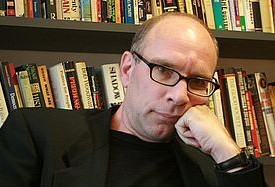Blog Archives
New News: Innovation in Journalism – what might it look like?
The time is ripe for change and innovation in journalism, with the proliferation of new technology, information sourcing devices constantly at punters’ fingertips and widely publicised missteps by media behemoths. David Higgins, News Limited’s innovations editor, Sam Doust, ABC Innovation,’s creative director and Jay Rosen, New York University joined Margaret Simons to discuss their ideas on how to innovate in journalism.
 Where did the idea for this session come from? When writing a story on the future of Fairfax for The Monthly, Simons asked a senior executive how they were going to innovate journalism, the interviewee said ‘What do you mean’? Although the media is changing quickly, the core of the journalistic method hasn’t changed very much since printing press was invented; Simons argued that no other industry can say the core product has stayed so constant.
Where did the idea for this session come from? When writing a story on the future of Fairfax for The Monthly, Simons asked a senior executive how they were going to innovate journalism, the interviewee said ‘What do you mean’? Although the media is changing quickly, the core of the journalistic method hasn’t changed very much since printing press was invented; Simons argued that no other industry can say the core product has stayed so constant.
Is it possible to change the way we tell stories or communicate news? Higgins suggested that it’s possible to vary the presentation of news and reach different audiences through ‘gamification’. During his tenure as website editor for the Sydney Morning Herald and news.com.au, fighting in Sudan was intensifying, yet he ‘couldn’t get people to read these stories no matter how good the journalism was’. MTV, of all outlets, said Higgins, came up with an idea that cut through this – a computer game called Darfur is Dying. The difference between this method of storytelling and how a journalist or foreign correspondent would tell the story was startling, and Higgins stressed that he wasn’t suggesting games as the new face of journalism, but one ‘attempt to get a level of differentiation into journalism – why we’re suffering is there’s so many similar versions of the same stories out there’.
Sam Doust took to the projector to demonstrate some of the new presentation and marketing ideas the ABC is using to showcase its work. Their The Explainer tumblr contains many of these examples. For instance, to complement the Rear Vision radio program on how to get out of Guantanamo Bay, an interactive flash and html animation was created. This was just one way to reach people who might not beading the articles; the Journey through Climate History moving timeline is a visually engaging interface for engaging with the information itself, which, Doust said was of course more important than any visualisation technique.
Jay Rosen agreed with this, saying that innovation doesn’t necessarily involve building new tools or programming machines: ‘The tools I’m interested in are people, ideas, and the will to do things differently’. Rosen called this ‘soft’ innovation – changing the way you do journalism, which often uses new tools but isn’t strictly about that. What kinds of innovations would involve readers working with journalists (‘mutualisation’ in Rosen’s parlance)? Take a look at openfile.ca – anyone who wants to can ‘open a file’; that is, prompt an investigation. Editors then assign a story to a reporter. Stories that come up through this method are five to seven times more visited than those their editors suggested. Another way to do this is covered in Rosen’s blog post, The 100 Percent Solution: decide on what you want to cover, and work out how to cover all of it. How exactly could you do this? Deputise your users in, for example, tweeting comments, scores and images.
Many of the audience members either took this advice to heart or didn’t need it: the #newnews hashtag was getting a thorough workout, with heads bent over smartphones and fingers tapping away on laptops throughout the session.
Blogger’s picks for MWF 2011
I’ve started circling events in the MWF program. Terrifying and all-encompassing though the red pen carnage may seem, there are some events I know I won’t miss.
 Usually my list is fiction-heavy, but thanks to the growing hubbub about digital news and the recent resurgence in interest about the ethics of journalism, New News 2011 has been a focus of my festival planning this year. New News 2011 will bring together media leaders and commentators from all over Australia and the world, including New York University media critic Jay Rosen, chair of the Public Interest Journalism Foundation Margaret Simons, and ABC Managing Director Mark Scott. Rosen’s Big Ideas: Why Political Coverage is Broken promises electrifying analysis of journalism today, and Media Leaders Held to Account offers one intrepid participant the opportunity to share the stage with Mark Scott and Crikey‘s Sophie Black (to be in the running, submit a question at OurSay).
Usually my list is fiction-heavy, but thanks to the growing hubbub about digital news and the recent resurgence in interest about the ethics of journalism, New News 2011 has been a focus of my festival planning this year. New News 2011 will bring together media leaders and commentators from all over Australia and the world, including New York University media critic Jay Rosen, chair of the Public Interest Journalism Foundation Margaret Simons, and ABC Managing Director Mark Scott. Rosen’s Big Ideas: Why Political Coverage is Broken promises electrifying analysis of journalism today, and Media Leaders Held to Account offers one intrepid participant the opportunity to share the stage with Mark Scott and Crikey‘s Sophie Black (to be in the running, submit a question at OurSay).
One fiction writer who has raced up my list of to-sees is Steve Hely, whose How I Became a Famous Novelist is a magnificently titter-inducing work of satire. The novel tells the story of a down-and-out college entrance essay writer who cracks the code of the best-selling literary novel (‘Rule 16: Include plant names’). As well as being a novelist, Hely writes for television programs 30 Rock, The Office and American Dad, and it shows in his mortifyingly acute descriptions (‘The only other customer at the coffee bar…was tearing apart a cranberry-raisin muffin with frantic violence. Crumbs were strewn across her open copy of The Jane Austen Women’s Investigators’ Club.’) Not for reading die-hards who cannot laugh at themselves. Hely is appearing in TV Tales, with Wendy Harmer, Tim Ferguson and many more TV writers; The Morning Read, always a lovely way to ease yourself into festival season; The Comedy of Publishing, and Friday Night Live.
titter-inducing work of satire. The novel tells the story of a down-and-out college entrance essay writer who cracks the code of the best-selling literary novel (‘Rule 16: Include plant names’). As well as being a novelist, Hely writes for television programs 30 Rock, The Office and American Dad, and it shows in his mortifyingly acute descriptions (‘The only other customer at the coffee bar…was tearing apart a cranberry-raisin muffin with frantic violence. Crumbs were strewn across her open copy of The Jane Austen Women’s Investigators’ Club.’) Not for reading die-hards who cannot laugh at themselves. Hely is appearing in TV Tales, with Wendy Harmer, Tim Ferguson and many more TV writers; The Morning Read, always a lovely way to ease yourself into festival season; The Comedy of Publishing, and Friday Night Live.
Finally, the world has been keeping a close eye on the Middle East this year, with a chain of political upheavals generating debate, concern and hope. As Egyptian commentator and journalist Mona Eltahawy has said, ‘Tunisia allowed us to imagine a future beyond our dictators. And everybody was watching Tunisia. And then everybody started watching Egypt and then Bahrain and Yemen and Libya and Syria. So, everybody’s paying attention.’ I’m looking forward to Eltahawy’s analysis in Big Ideas: The Roots of the Egyptian Revolution – From Tahrir Square to Liberation From Dictatorship. You can see Eltahawy commenting on the trial of Hosni Mubarak here, and on the Syrian blogger hoax here.
What are your festival picks?
Whither goest thou, media?

Margaret Simons
With all the problems facing traditional news media as we know it — the proliferation of media outlets, the decentralisation of power from the traditional strongholds of Packer-esque families, the advent of online content and the increase in citizen journalism — Finding Meaning in the Media might well have been considered a self-help session. Instead, Margaret Simons and vigorous chair Jeff Sparrow held forth on these issues in a most adroit fashion.
Change is natural in any context. But in relation to journalistic media, one of the most important changes has been what people want from it. No longer do people wait for the newspaper to be published; they can simply hop online and find out through Twitter or news websites. So does this mean that there is less demand for news content? Simons thinks not. In fact, ‘there is no evidence for a declining appetite for news.’ The figures for print are declining, but throw online content into the mix, and you get a better picture of the increased demand for news.
Newspapers, then, are declining in their ‘social purpose’. News media consumers should be wary of this breakdown, as this means that there will be fewer professional brokers of information, whether it’s simple reporting or more involved investigative journalism, In that case, where will we get our news from? The internet is the obvious place to look, with dissemination models ranging from single-person blogs to niche providers such as Crikey’s incredibly successful Eureka Report. Not only does this media revolution affect our news paradigms, says Simons, but also how we organise our societies.
What path then for young people just getting their journalistic shoes on? Simons, a tongue-in-cheek shill, suggested the new course she has put together at Swinburne University, which includes traditional elements such as writing skills and good old fashioned story-seeking research; but also elements that embrace the specificities of new media spaces, including how to facilitate community and using social networking platforms. The most interesting thing to come out of Simons’s involvement with Swinburne is, to my mind, the Foundation for Public Interest Journalism, which investigates new models of journalism. One such model is a direct journalist-audience relationship, where a journalist can list their areas of interest or loose pitches and audiences can fund articles of interest, similar to Etsy’s successful Alchemy marketplace or the Kickstarter artist funding program.
Margaret’s book The Content Makers is due out in September through Penguin: probably a must-read for anyone who read more than the first line of this post.
Estelle Tang, 3000 BOOKS
Festival Blogger